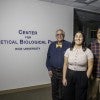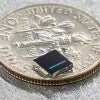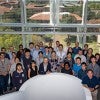
Rice Sustainability Institute and Chevron partner to empower next-gen sustainable energy leaders
The Rice Sustainability Institute announces the inaugural recipients of the newly created Rice Chevron Energy Graduate Fellowship.

Rice Sustainability Institute and Chevron partner to empower next-gen sustainable energy leaders
The Rice Sustainability Institute announces the inaugural recipients of the newly created Rice Chevron Energy Graduate Fellowship.

‘Out of all the unknowns in science, we have so much to discover’
Rice’s Smalley-Curl Institute held its 38th annual Summer Research Colloquium Aug. 2 at Rice’s Duncan Hall, where undergraduate and graduate students and postdoctoral researchers gave presentations covering topics in nanoscience, quantum materials and quantum information science and technology to a multidisciplinary audience.

Rice’s Emilia Morosan awarded prestigious Vannevar Bush Faculty Fellowship
Physicist wins Department of Defense’s most prestigious single-investigator award

Rice neuroscientists to build state-of-the-art neural recording system
Rice neural engineer Chong Xie and his team have won a $2.9 million R01 grant from the NIH to develop a state-of-the-art implantable neural electrode system that is highly biocompatible, untethered and capable of stable, long-term and large-scale neural recording and stimulation.

Future of bioelectronics takes center stage at Rice Global Paris event
The Rice Global Paris Center hosted the BioElectronic Therapeutics (BETx) conference and workshop June 27-28, the first formal event dedicated to the field of bioelectronics to be held at Rice’s Paris campus.

Rice chemist Gustavo Scuseria wins 2024 Schrödinger Medal
Pioneering Rice chemist Gustavo Scuseria has won the 2024 Schrödinger Medal from the World Association of Theoretical and Computational Chemists.

Rice study reveals insights into protein evolution
Rice University’s Peter Wolynes and his research team have unveiled a breakthrough in understanding how specific genetic sequences, known as pseudogenes, evolve. Their paper was published May 13 by the Proceedings of the National Academy of Sciences of the United States of America Journal.

Junichiro Kono tapped to lead Rice’s Smalley-Curl Institute
Rice University’s Junichiro Kono has assumed leadership of the Smalley-Curl Institute, named for Nobel Laureates Richard Smalley and Robert Curl ’54 and home to some of the world’s most accomplished researchers in nanoscience, quantum science and materials science.

Rice research shows promise for advancing quantum networks
Rice engineers have demonstrated a way to control the optical properties of an atomic imperfection in silicon material known as a T center by embedding it in a photonic integrated circuit and exploiting the Purcell effect to strengthen light-matter interaction and increase the rate of spontaneous emission.

Electronic pathways may enhance collective atomic vibrations’ magnetism
A new study from Rice’s RAMBO laboratory and collaborators suggests the magnetism of phonons, collective atomic vibrations, is enhanced by electronic pathways.

Rice hosts International Workshop on Quantum Vacuum in Matter
Rice recently hosted the first International Workshop on Quantum Vacuum in Matter, an event that brought together leading experts in the field from around the world to discuss recent advances, discoveries and research priorities.

Atomic dance gives rise to a magnet
Rice researchers turned a paramagnetic material into a magnet by manipulating electrons’ spin via atomic motion.

SCI Summer Research Colloquium awards; Applied physics students study in France

32 Rice students, alums win NSF Graduate Research Fellowships
The National Science Foundation has awarded Graduate Research Fellowships to 32 current, incoming and former Rice students, and selected another six for honorable mention.

Rice team begins ambitious quantum entanglement research
A Rice research team has begun an ambitious three-year project to see quantum entanglement among billions of particles in a solid material thanks to a $1.2 million grant from the Keck Foundation.